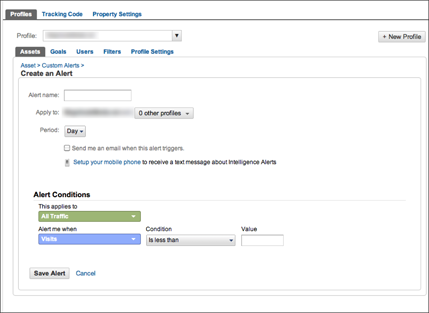Figure 11-3: Creating a custom alert.
Avoiding Metrics Pitfalls
There are many metrics pitfalls out there. You can easily avoid most of them with a little planning and a different outlook on what you want your metrics to do for you.
Don’t overstate your numbers
Metrics excite some people, but for many, they’re math. Math has this stigma of being boring (even when the information it gives us is useful), so sometimes you see metrics that are inflated or otherwise altered to be more exciting.

Avoid this mistake. One problem is that it makes people stop listening to you if your numbers always come in overstated. Another is that is calls all your data into question and helps no one.
Don’t get obsessive
Checking your metrics daily is often a bad idea. Unless you’re running a well-targeted, well-planned, multichannel 24- or 48-hour campaign, most daily metrics don’t give you the whole picture.
It’s tempting to obsess ...
Get Social Media Metrics For Dummies now with the O’Reilly learning platform.
O’Reilly members experience books, live events, courses curated by job role, and more from O’Reilly and nearly 200 top publishers.
 There is no shame in a low metric, if it’s true. A low metric is simply an opportunity to improve your efforts or improve your data collection. It’s a way to open up discussion on the underlying issue that is causing the low number. Low metrics may not look valuable on the surface, but they are often the most valuable number you can receive — a chance for improvement.
There is no shame in a low metric, if it’s true. A low metric is simply an opportunity to improve your efforts or improve your data collection. It’s a way to open up discussion on the underlying issue that is causing the low number. Low metrics may not look valuable on the surface, but they are often the most valuable number you can receive — a chance for improvement.
